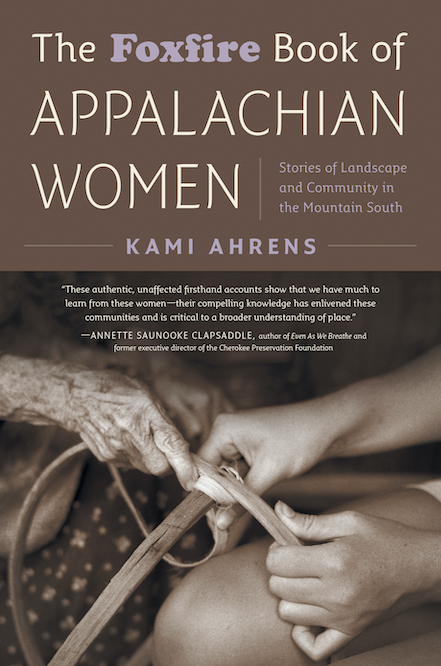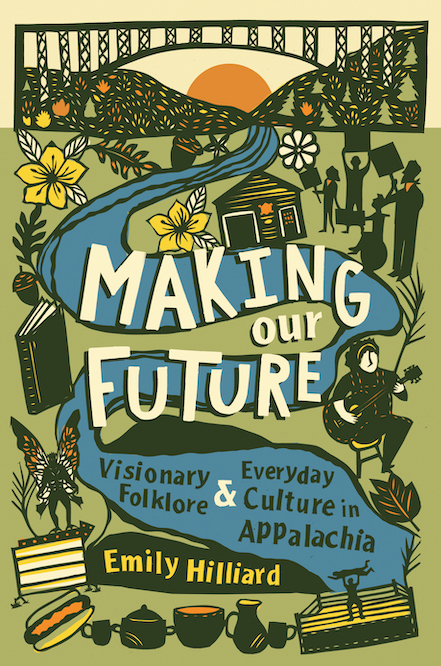Discovering the Soil All Over Again
An interview with Museum of Appalachia founder John Rice Irwin
FROM THE CHAPTER 16 ARCHIVE: This article originally appeared on June 14, 2022
***
On Valentine’s Day 2008, I spent an afternoon talking with an East Tennessee legend, John Rice Irwin, founder of the Museum of Appalachia. Our interview was conducted beside a crackling fireplace, interrupted only by a delicious homemade lunch from the museum’s kitchen.
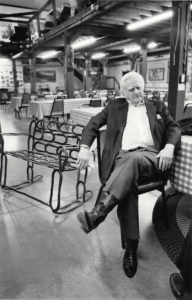
Mr. Irwin generously welcomed my wife and daughter to join us for the meal and for a tour of the grounds. We talked extensively about our common ancestry that traced back to the 1780s, with the family of Henry Scharp and Barbara Graff. These were the very first Europeans to settle in what later became the homeplace of my childhood and his, the community of Sharps Chapel, in Union County, Tennessee. (“Scharp” and “Graff” are the original German names that became Sharp and Graves.) I was touched by Mr. Irwin’s warmth and genial manner and was delighted to learn that we were in fact cousins by blood, as well as bound by the kinship of our shared love for the folkways of our native region.
When John Rice Irwin passed in January 2022, I thought not only of our interview, but of all the other treasured days I had enjoyed at the Museum of Appalachia. My family spent my dad’s 70th birthday at the annual Fall Homecoming celebration. My parents and I heard Bill Monroe, the “Father of Bluegrass Music,” perform one of his final concerts on the main stage at an earlier Homecoming. I still smile at the memory of my five-year-old daughter laughing with delight at the antics of the famed museum peacocks. Years later I visited as a teacher on a field trip with a group of mesmerized students from the Appalachian Young Writers’ Workshop.
In an expansive obituary for Mr. Irwin, The New York Times called him a “guardian of Appalachia’s past,” and I was pleased that his life received the recognition it deserved from so far away as New York. Mr. Irwin preserved the region’s past and offered us a fuller sense of the lives of our ancestors, and he gave us a living space to come together and enjoy learning about our shared history.
Mr. Irwin was an accomplished writer and historian, as well as the founder of a major American museum. He wrote books about quilts, baskets, and hunting rifles, and these were also about quilters, basket makers, and gunsmiths. The lives of craftspeople meant as much to him as the works of art they created. John Rice Irwin always wrote the people’s story. In choosing the topics for his books and museum archives, he seemed to intuitively understand the historical discontinuity that would follow children no longer learning the way of life of their grandparents.

When I began transcribing the following interview in the early spring of 2008, I looked at my list of questions and felt a pang over the ones I did not have time to ask. How did he come to write his master’s thesis in history at the University of Tennessee about U.S. trade relations with Yugoslavia? Was there an artifact out there that he wished he could have acquired for the museum — a special one that got away? Were there still books he wanted to write? So many questions I wish I had been able to ask. I saw Mr. Irwin a few more times through the years at the museum, for the Fall Homecoming celebration or other occasions, but never had the chance to sit with his undivided attention again.
I had come to talk with Mr. Irwin in 2008 because I was a co-editor with Jessie Janeshek of Outscape: Writings on Fences and Frontiers, published by another great East Tennessee organization, the Knoxville Writers’ Guild. Outscape was the first book that would have my name on the cover as an author or editor, and it provided a wonderful opportunity for a pair of young writers to learn about the work that goes into building a book.
Mr. Irwin had written a moving and insightful introduction to the 1998 Knoxville Writers’ Guild anthology The Voice of Memory: A Collection of Memoirs, which quickly sold out and had been unavailable for many years. It seemed fitting to include his voice in a collection of writings on fences and frontiers since he has overcome many obstacles to preserve a little-understood culture and shape the museum he founded in 1969 into one of the most celebrated historical institutions in America. As a native of East Tennessee, I had known John Rice Irwin as a larger-than-life figure, the preserver of an era and a way of living I had heard stories about but was born too late to experience myself.
Mr. Irwin’s wife, Elizabeth, passed away shortly after our visit. It was clear that her illness weighed heavily on him during our day together, so much so that when I learned of the situation, I asked if he would like to talk again some other day. “No,” he said, “I think it would do me good to talk about old times today.” As with its original publication in 2008, I would like to dedicate this interview to Elizabeth Irwin’s memory, and now also to the memory of her husband, John Rice Irwin.
Jesse Graves: Mr. Irwin, will you tell me about where you grew up?
John Rice Irwin: My people settled in a part of East Tennessee that they called Big Valley. They call it all Sharps Chapel now, and the first of them to settle there were Sharps. Virtually all my people lived there, the Longmires, the Snodderlys, the Graves, the Irwins, the Rices. I was born in Knox County when my father and mother lived with my grandfather Rice, and we moved back to Big Valley when I was about one year old. When TVA built Norris Dam, they bought us out, and we moved to Robertsville, where Oak Ridge is located now. Then in about seven years the government followed us and bought us out again to build the nuclear facilities.
Graves: So, your family’s land was requisitioned twice and you were removed twice in less than 10 years?
Irwin: That was in 1942. Those are some of the strongest memories that I have. We lived after that on the same farm as my Grandfather and Grandmother Irwin. My grandfather was born in 1860, and he was always interested in history and the old people, and he could remember people whose mothers and fathers lived in the Revolutionary War period. That enabled me to have a little perspective, a link to the very first settlers. He was up in years and not able to do a lot of farm work, and kept busy in the gardens and taking us kids down on the creek to fish, or up on the ridge to hunt. We would find possum grapes, fox grapes, summer grapes, he taught us the difference between those three, and pointed out what a hazelnut tree looked like.
Graves: Can you still tell those grapes apart and remember the other things he taught you?
Irwin: Oh sure. I don’t think he ever realized that he was teaching us anything. That wasn’t his purpose, but I remember so much of what he was telling us. Today you don’t really think about how to cut a tree down, 2 or 3 feet in diameter. The average person could work a week on it hacking away, but my grandfather knew how to do things like that, and how to tap the sugar trees, in the most effective way.
Graves: Did you get your interest in history from what he taught you?
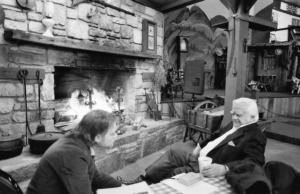
Irwin: Well, I suppose, and I also spent some time with my Grandfather Rice, who lived about 45 minutes from where we did. So, we visited only rarely, but I still remember so many of the things he told me. He was interested in history, too — he left home to work in coalmines, then he went out to some of his relatives out in Clay County, Missouri, to work as a laborer. He was always considered one of the hardest working men around. Now my Grandfather Irwin would sit around on the porch and read the papers and the Bible, and he liked to talk about what he was reading.
Graves: Was he a good storyteller? Or did anyone else in your family tell stories?
Irwin: Oh yes, but they never considered they were telling stories — it was just what people did then. My Grandfather Rice, when he was in Missouri, worked on the farm adjacent to where Jesse James’ mother lived and helped dig for the gold Jesse was supposed to have buried there. He stayed with a sister to one of the Dalton Gang, who all were originally from East Tennessee, I believe. He always said what a kind woman she was — she made him a batch of biscuits for his trip home. He homesteaded in Oklahoma, and he also served with Colonel McGhee Tyson on a ship off Puerto Rico. Grandfather Rice always talked about the adventures he had before he came back to Tennessee when his father became ill.
Graves: What gave you the idea to move from your family’s oral history into written history? What prompted you to write it all down?
Irwin: Well, I don’t know that I have an answer to that. A lot of young people have an inclination to write poems and stories, and I did that too. I started writing for the local newspaper when I was in high school. I guess everything revolves around my interest in people — I get asked sometimes about the museum, why did I start it and so forth, and I never could come up a with a good answer, but it really started with me collecting the things that belonged to my grandparents. If you have an old item, and you don’t know the history of it, and you don’t know who made it, what it was used for, who kept it over the years, it doesn’t mean too much. If you separate the history from an item, then you’ve destroyed it to a great extent.
Graves: Do you know the history of most of the items in the museum?
Irwin: Well, this chair beside the fireplace is made out of mule-shoes, and it belonged to Uncle Dave Macon, the Grandfather of Country Music. He hauled freight and sold produce and other jobs even while he performed, and once he had a load of horseshoes that he couldn’t sell. He didn’t know what to do with them since people were using automobiles more and more. So, his son used them all to make chairs and benches — Uncle Dave was one of the best-known entertainers of his time, and yet he remained so thrifty.
Graves: I really like how all the artifacts here in the museum are labeled with a marker — it gives the museum a handmade feel. Did you write all these yourself?
Irwin: Yes, I wrote them all by hand. In the beginning, I didn’t have anybody to help, but then I knew that I had to do it, because I personally knew Tyler Bunch from Snake Hollow, for instance, and I had to get that feeling of knowing the people and artifacts into the captions. My granny Irwin always said that nobody could ever do anything to suit her, and that may be how I am, too.
Graves: What was the first thing you wrote about?
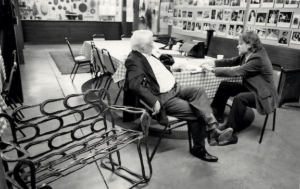
Irwin: I went out to Norris Dam one day and there was a grist mill built by James Rice, my three-times great-grandfather. There was a lot of traffic back then to see the dam, and people would ask about the mill. The attendant didn’t know anything about it, so I decided to write a pamphlet and have it printed up to sell there. I had it printed by the Clinton Courier News, and the man said, “I hope you sell a million copies!” Well, we sold them for a quarter, and they sold out. This mill was built in the 1700s and nothing has been written about it at all. I worried that people would eventually forget the story of how it was built. After my family had to leave Oak Ridge, I wrote a long poem about that experience in an old Longfellow-type style. My Uncle Martin Rice wrote poetry — he was from up in Sharps Chapel where your people are from. He moved out west and wrote a book about his life out there called Rural Rhymes of Olden Times.
Graves: Did you have a sense of yourself as a writer or an artist when you were growing up?
Irwin: No, I just had an interest in so many things, and I wanted to tell their stories. I really wanted to write the story of my grandfather, which I did, called Marcellus Moss Rice and His Big Valley Kinsmen. I never had to go out looking for subjects to write about — I was born into my subjects.
Graves: You have preserved a disappearing culture here at the Museum of Appalachia. Do you think people will keep a sense of connectedness to the past?
Irwin: Well, it will be most difficult, because fewer people have first-hand experience of how things were done in the past. The farm I grew up on was almost totally self-sufficient, and our lifestyle in the 1930s was not all that different from life on a farm in Europe a thousand years ago. There was no problem in passing on a culture because so many things continued to be done in the same ways. If I had been exposed to all the technology that kids today are, I might have been more interested in computers and video games just like they are. It isn’t practical to turn back and do things in the old ways, but there are several things that can be done today to keep people in touch with their ancestors. Composting and raising a garden, for instance. Once people start with a garden, which can be done almost anywhere, people get more and more interested, and enjoy it and see the value of it. I’ve already sowed my lettuce beds and can’t wait until it’s time to get more things into the ground. Every year, every spring, it’s just like discovering the soil all over again.
[The transcript of this interview was originally published in Outscape: Writings on Fences and Frontiers (2008), edited by Jessie Janeshek and Jesse Graves. It is reprinted with permission of the Knoxville Writers’ Guild.]

Jesse Graves is the author of four poetry collections, including Merciful Days, and a collection of essays, Said-Songs: Essays on Poetry and Place. His work received the James Still Award for Writing about the Appalachian South from the Fellowship of Southern Writers and two Weatherford Awards from Berea College. He teaches at East Tennessee State University, where he is poet-in-residence and professor of English.
